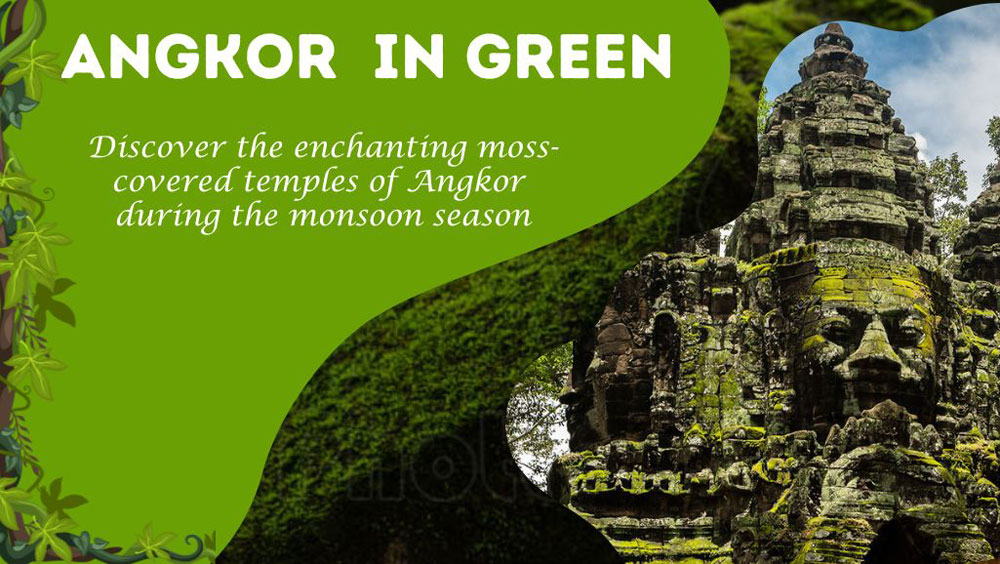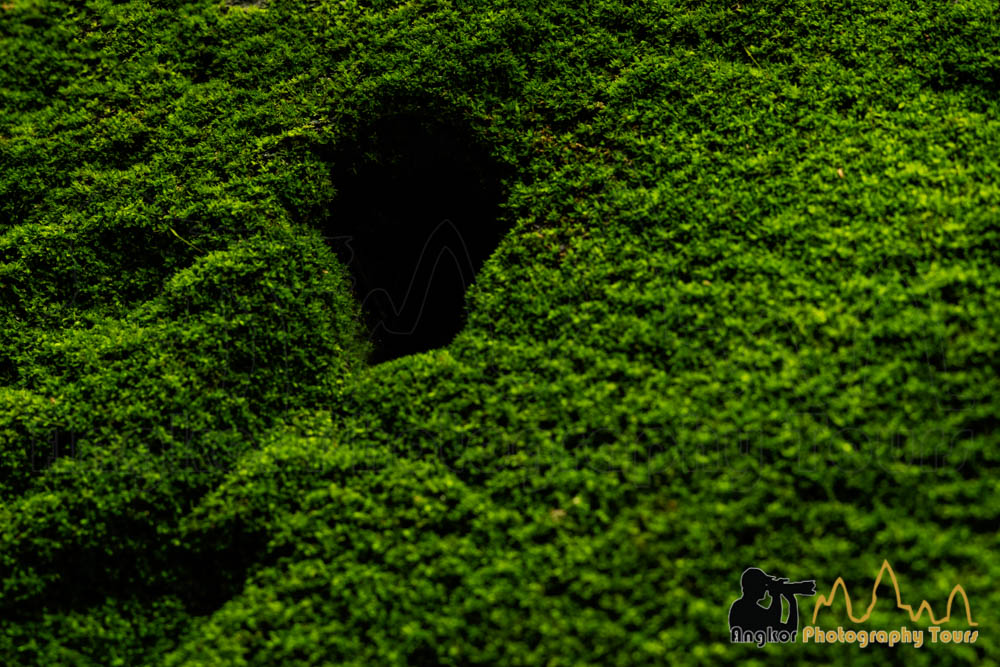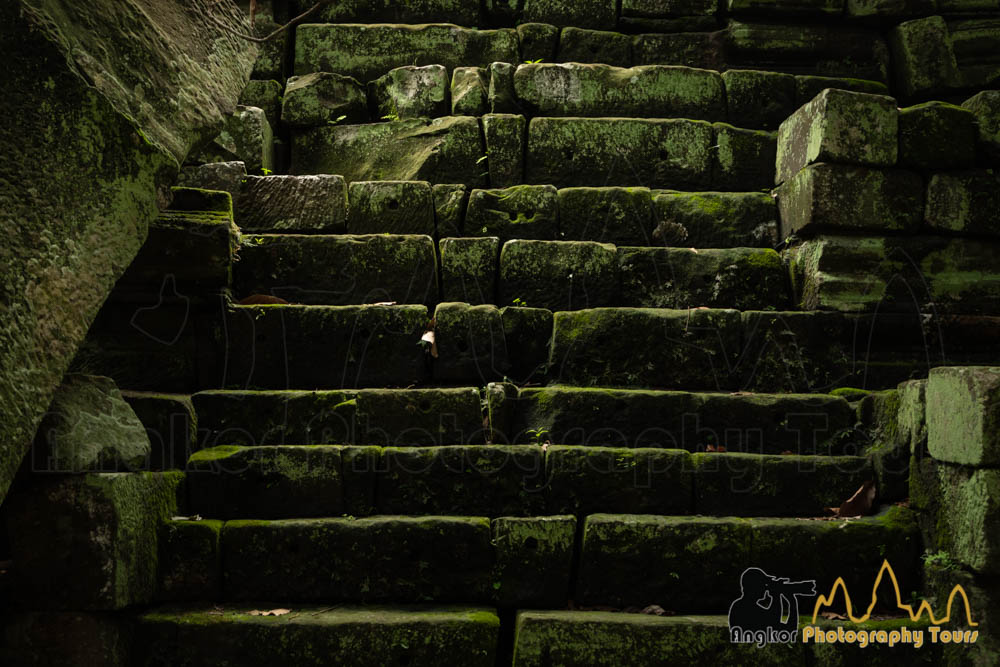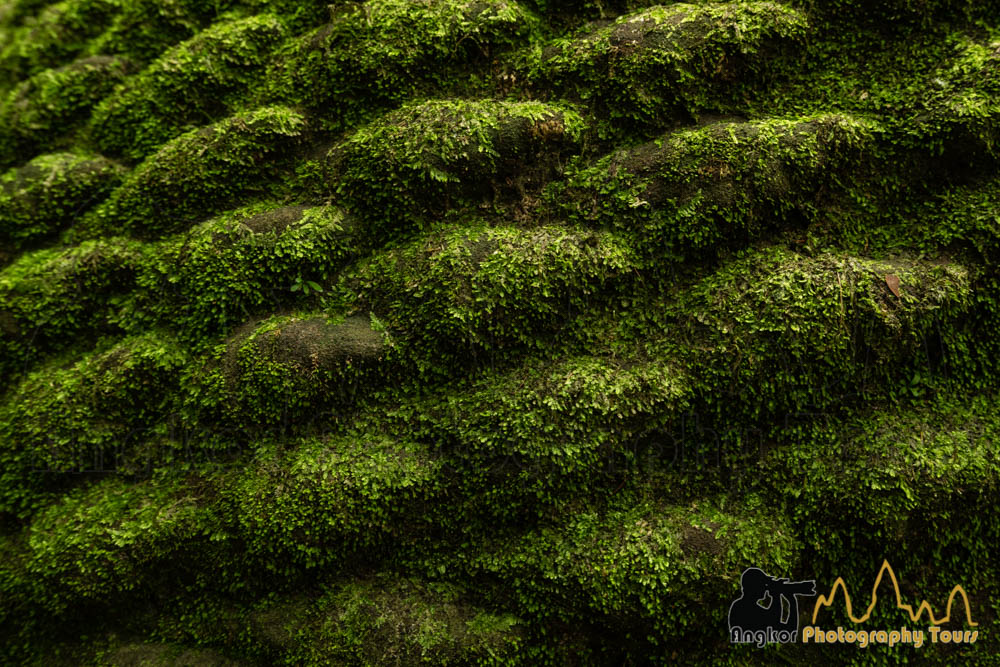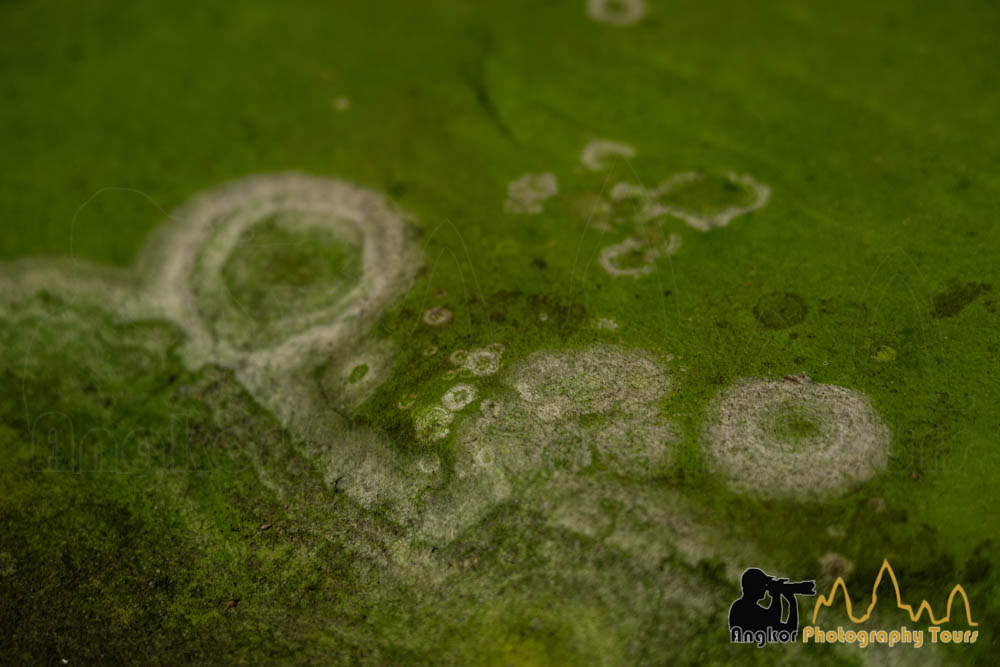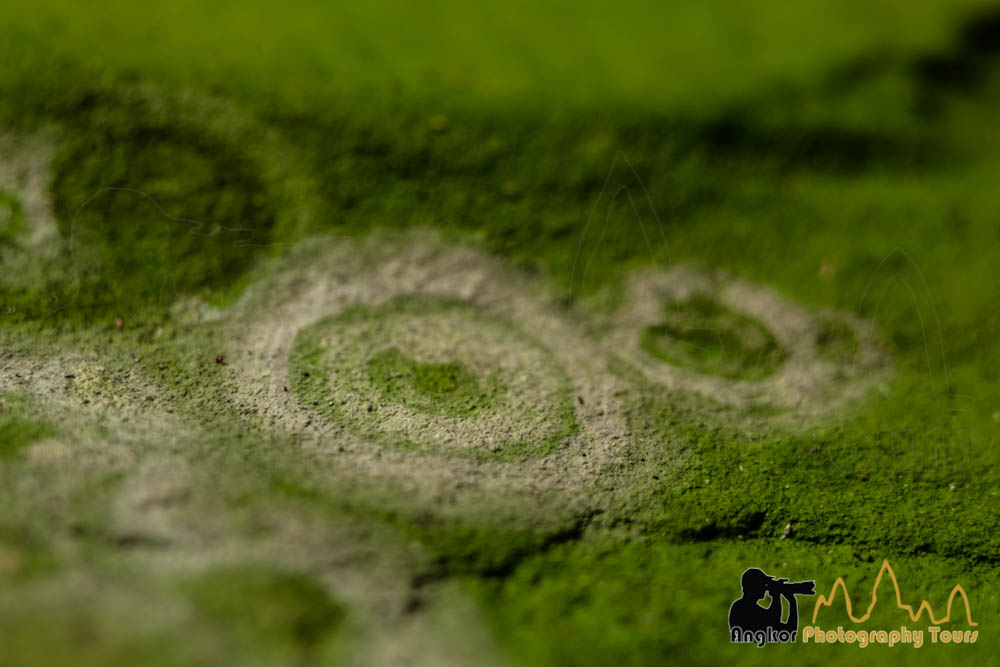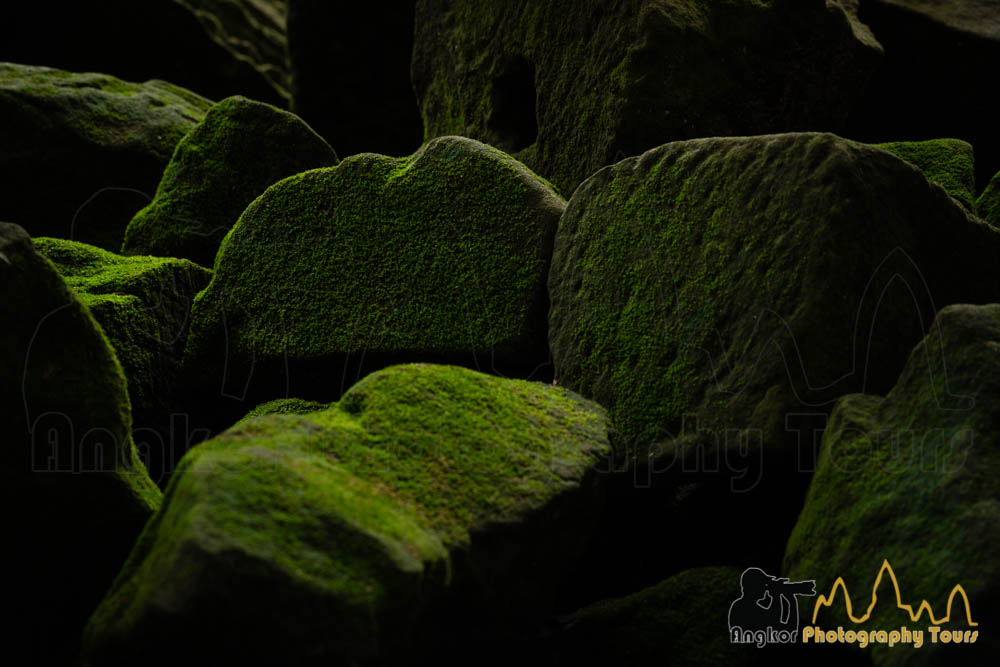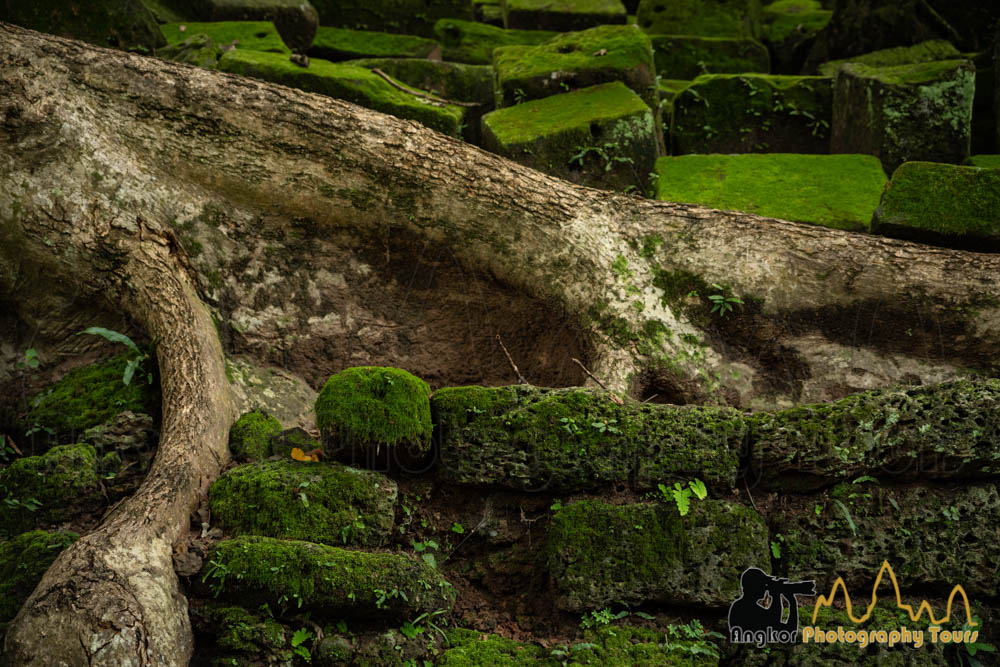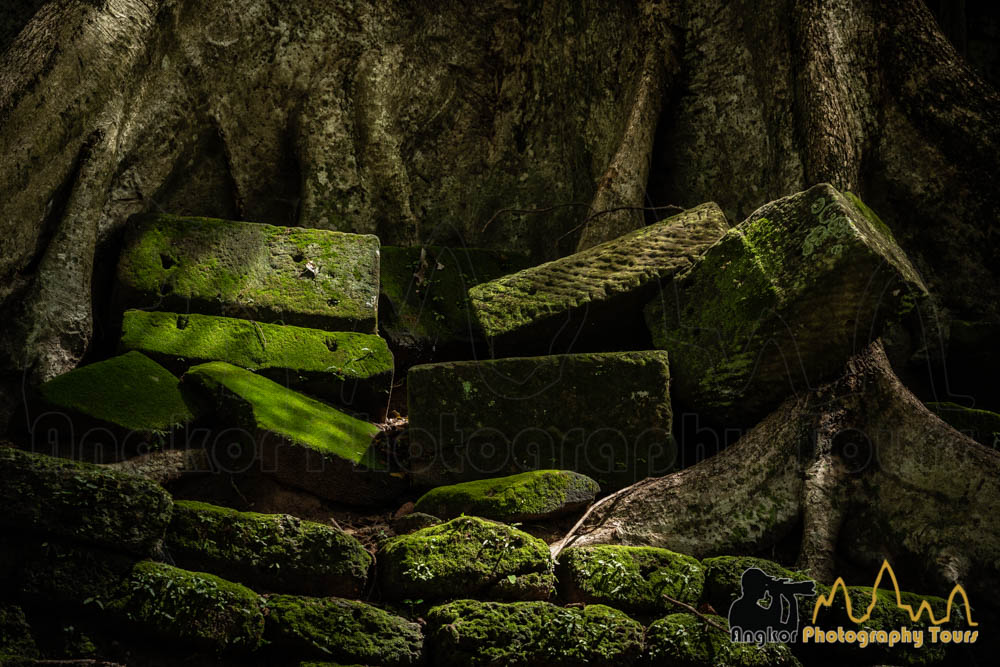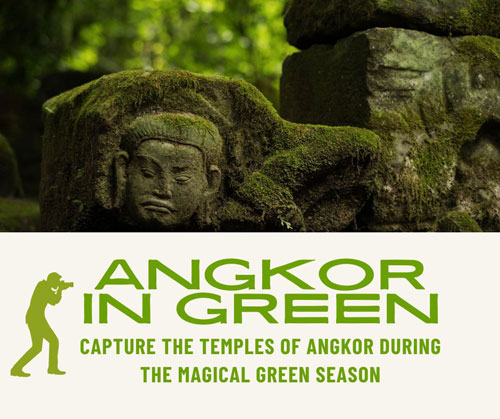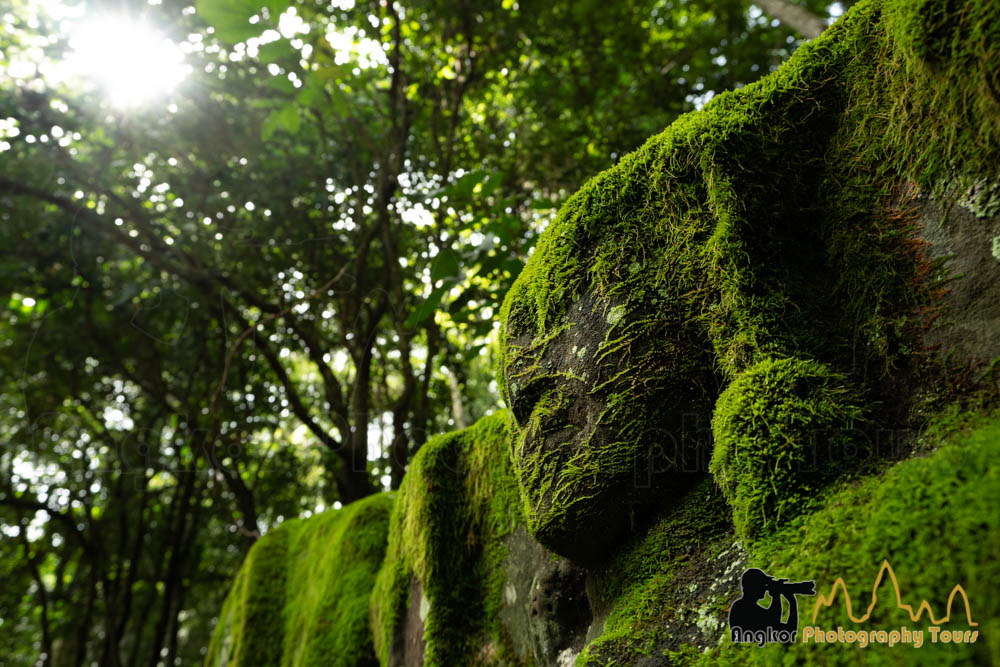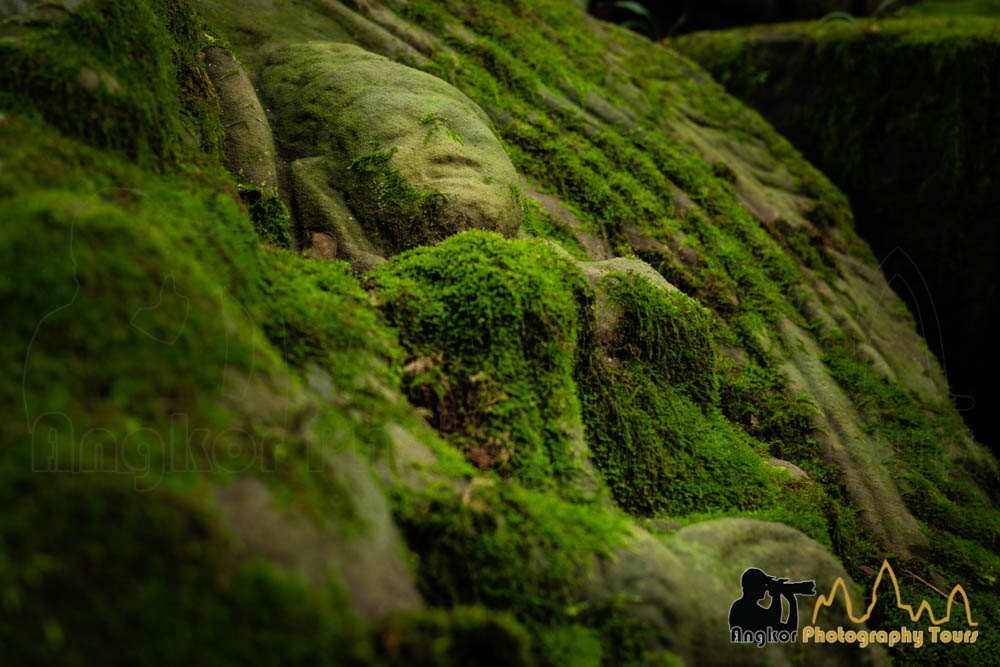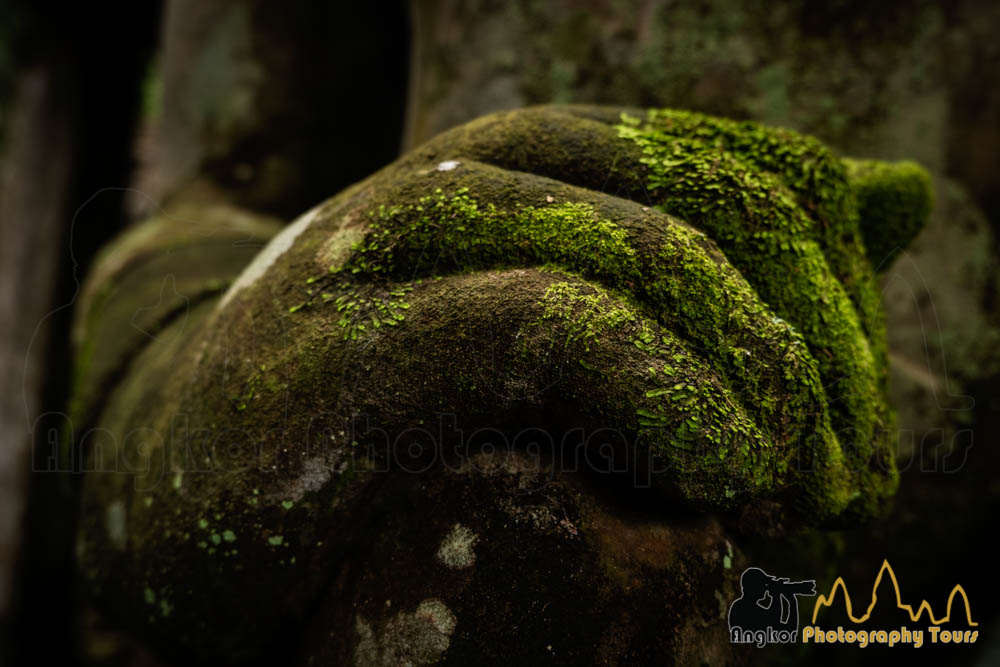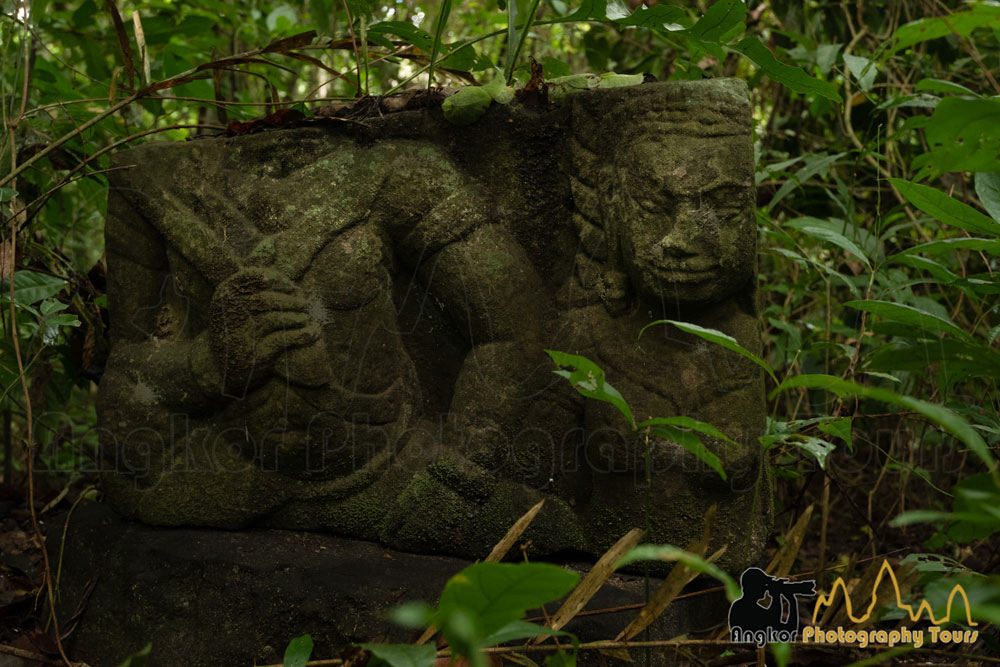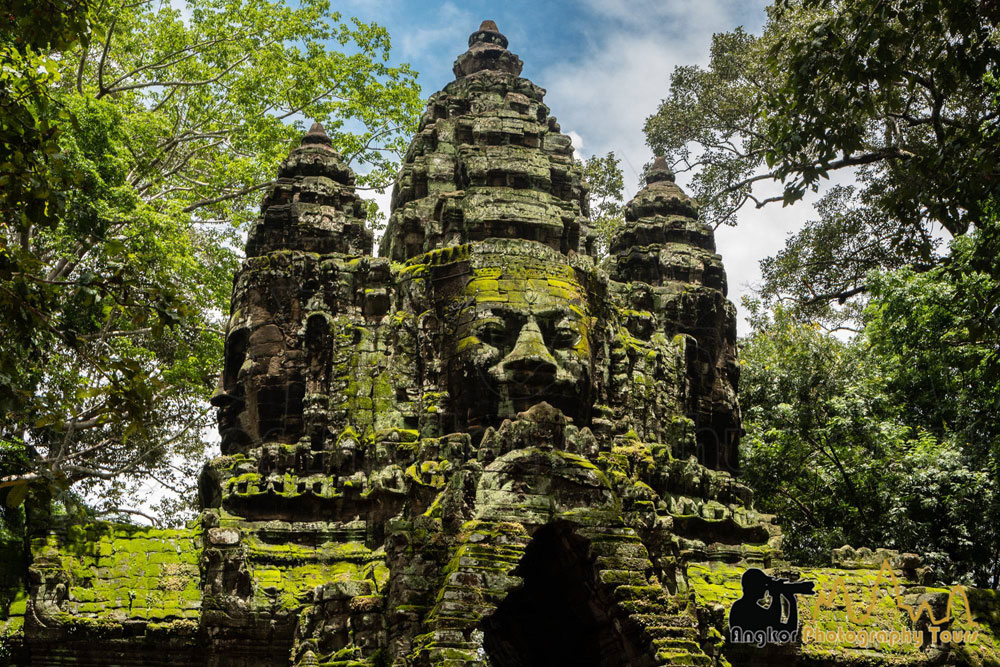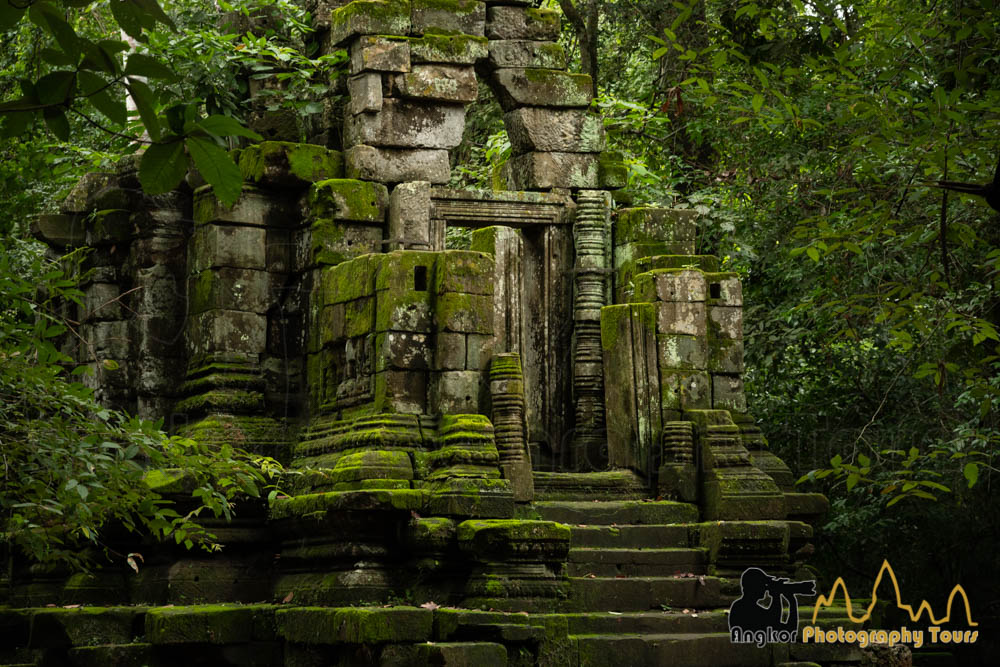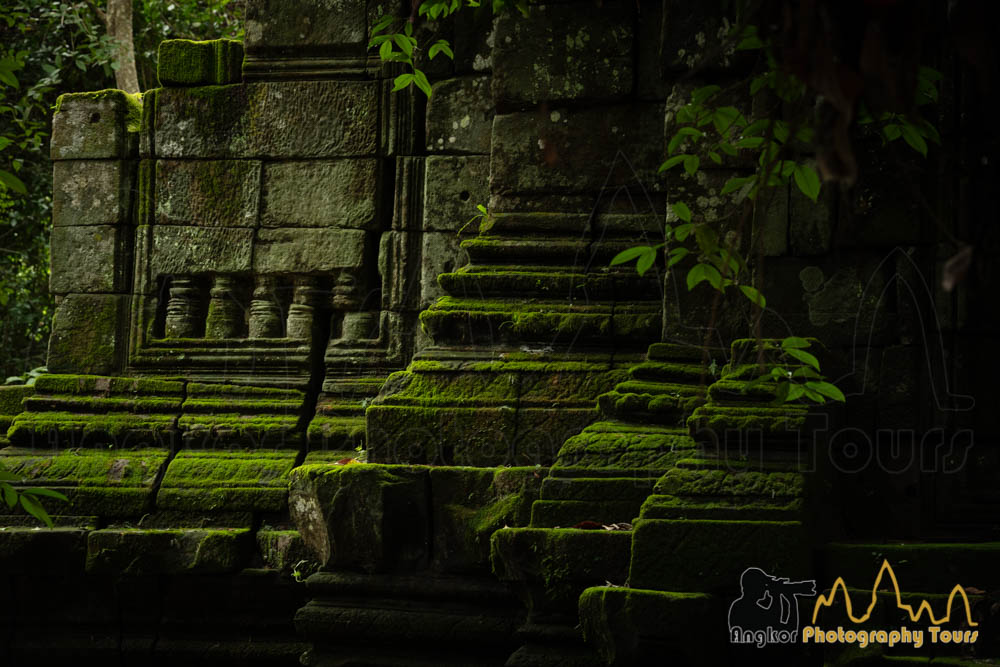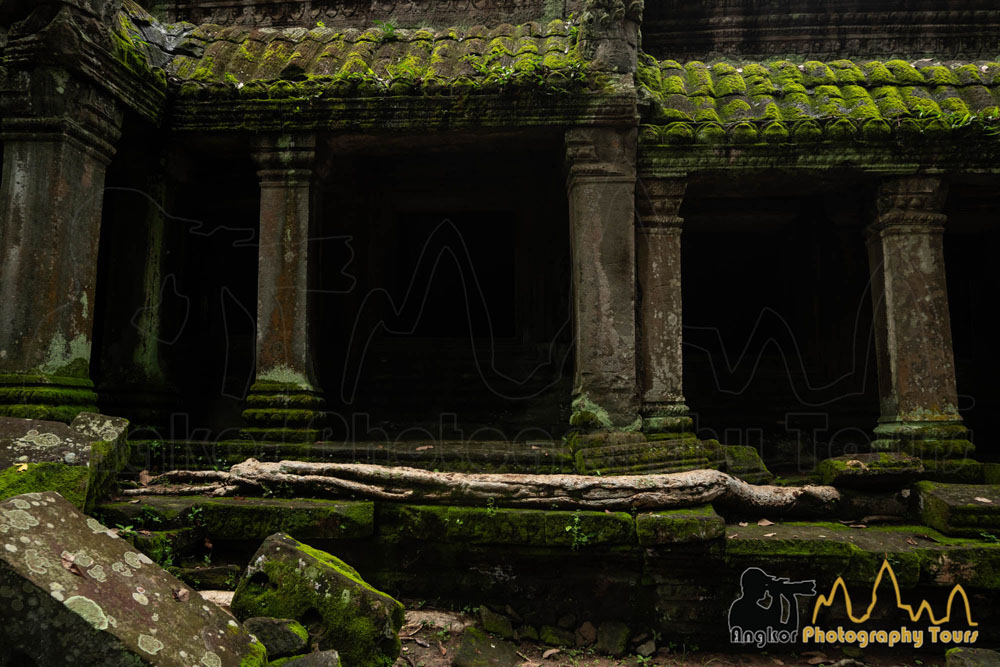If Angkor Wat temple does not have any mosses growing on its stones, the temples deeper in the jungle have plenty.
A closer inspection reveals that mosses are not the only ones responsible for the green. Some lichens (Pyxine) add some hues to the green palette. Occasionally, you can also find ferns and other plants growing between the stones.
These different species coexist during the green season and moss is generally found in the shadowed areas of the temples where water has a higher chance to stagnate.
If you are a photographer coming to Angkor during this season, you will be blessed with many unique photography opportunities whether shooting with a wide-angle or a portrait lens. Add to this the changing light passing down the clouds or filtering through the foliage and you will get unique pictures. In December. most of the moss starts to dry already and the deep green colors are fading.
During the Cambodia green season, even a boring piece of sandstone becomes a piece of art. You will probably not take a picture of it during the dry season.
All these pictures were taken in the temples of Angkor at the Cambodia green season during the very quiet month of September 2021. You will only meet a few souls in the temples due to lockdowns and the total absence of international tourists. This post is an extension of our previous blog Angkor in Green we published in 2015.
We organize the pictures in 3 categories:
- Volume and Textures
- Statues and Carvings
- Temples and Gates
ANGKOR IN GREEN | VOLUME AND TEXTURE
This series is all about volume and texture. What can be done with a camera is endless just by moving around to find different perspectives, backlit shapes, and many more.
In Angkor, two main types of stones can be found: sandstone, used to build the main temple structures, also easily carved, and the laterite (volcanic looking) mainly used to build walls and water management systems after the 10th century.
This piece of sandstone below was fully covered, except for a hole, by a thick layer of moss. This hole, quite small, was either used to carry the block or to attach bronze plates. The moss is dark green as we purposely underexposed the shot.
In the picture below, both moss and lichen cover the stairs giving some unique shades of green. The large block of sandstone leaning from the left end side adds a dynamic dimension to the picture.
In the picture below, we used a fisheye lens and not a macro lens to capture a large piece of sandstone of a lion’s chest. Several statues of fallen lions can be found in the jungle of Angkor if you spend some time looking for them or if you are lucky to have a private photography guide with you. Once again, the moss altered shapes and made the texture more interesting.
The shots below were taken using the macro mode to focus on a relative small area and get a shallow depth of field. These lichens, located on the lower part of a window made of sandstone, made for a quite abstract pattern.
Moss changes the perception of volume and it is especially noticeable when sandstone blocks are pilled up together looking like an abstract landscape. We played with the available backlit light to enhance the shapes.
In these two pictures below, we played with different textures: the moss on sandstone and rugged laterite blocks lying between the roots of an ancient tree partially covered by moss.
You can apply several compositions to the final picture, using layers, negative space, and placing some elements on dynamic points. We create a composition with three layers, a root going down breaking the frame in a dynamic point.
The second picture has a layered effect and because of the lightning, volumes become more apparent.
JOIN OUR ANGKOR IN GREEN PHOTO TOUR
ANGKOR IN GREEN | CARVINGS AND STATUES
Each monsoon season, carvings and statues get a new life getting even more photogenic. In the shot below, thick patches of moss (most likely Taxithelium Nepalese) are growing like tentacles partly covering a 13th century Buddha face and enhancing some of its features.
Unlike the volume and textures series which had a tight composition, in carvings it might be interesting to have a background. In the picture below, green foliage and the sun filtering through it were placed in the background; the main subject was placed carefully on a dynamic point.
On another carving, moss added a green patch to the hairdo of a beautiful devata.
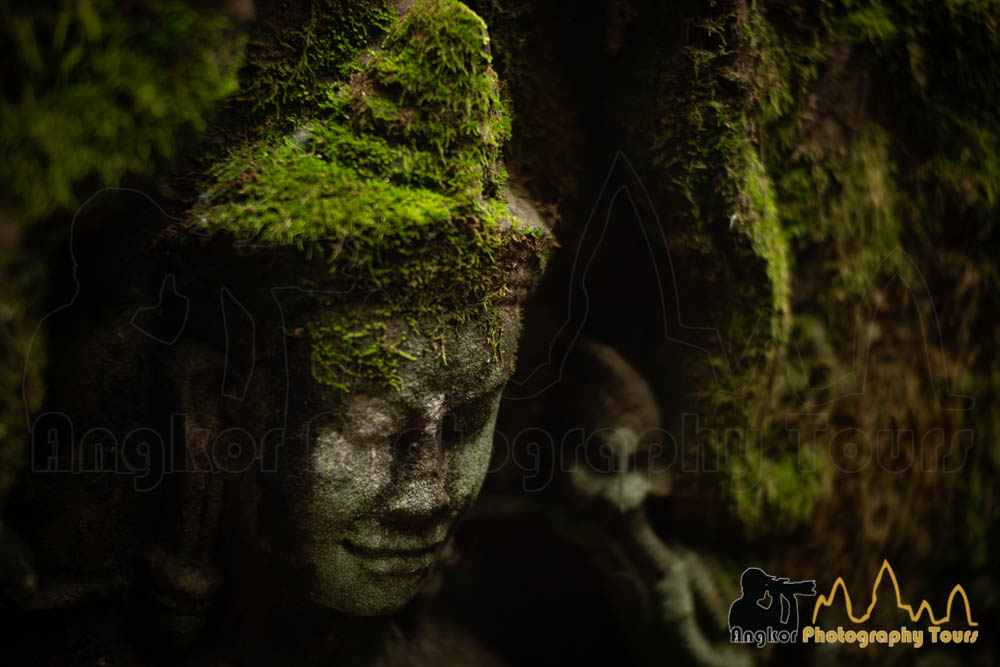
Cambodia monsoon season: Devata carving covered in moss
Moss covering the hand of a giant caught my eye from far away as I was about to enter one of the gopuras of Preah Khan temple.
It took few shots to get the best angle and get a human-like impression of the moss giving an unfinished glove to the standing giant.
Some carvings, but not many, are hidden deep in the thick Angkorian jungle. The one below got a handful of visitors during the last 100 years, mostly from archaeologists. Once again, we chose to include the lush foliage around shooting at a low angle, which can also give an idea of the size of the carved sandstone block.
ANGKOR IN GREEN | TEMPLES AND GATES
In this series, we move away from abstracts and close-ups to capture the jungle temples covered in green.
In this striking picture of Angkor Thom north gate below, you can appreciate the vivid green moss covering, green foliage, and deep blue sky with clouds. We took this picture when the sun was at the zenith, casting dramatic shadows on the faces and overexposing the moss giving a light green color.
The temples covered with the most moss are, with no surprise, the ones surrounded by trees where most of the sun is blocked during the day. In these temples, you don’t really notice a difference in coverage with the cardinal orientation. In the temple below, situated in a relatively dense area of jungle, moss is covering stones scattered and the temple itself, mostly on the lower part.
We carefully framed the small sanctuary with trees to add some depth to the image. In the picture below taken in the most famous of Ta Prohm, roofing pattern are enhanced by the moss and we can see a stark contrast between the green and tree roots.
If you want to learn more about the moss flora of Angkor, I would suggest reading the articles below from research work done by different international teams from Japan, Italy, Korea and the Netherlands in the temples of Angkor.
Moss Flora of Angkor, Cambodia. Higuchi, H. Bull. Natl. Mus. Nat. Sci., Ser. B, 35(3), pp. 141–150, 2009.
Noteworthy Lichens with Mazaedia Collected in Cambodia. Kashiwadani H, Aptroot A., Futagami, Y., Hee Moon K. J. Jpn. Bot. 87: 280–283, 2012
Biodeterioration of stone in relation to microclimate in the Ta Nei temple – Angkor (Cambodia)
. Caneva,G.Ceschin,S. Salvadori,O. Kashiwadani,H., Moon K.H, Futagami,Y. 12th International Congress on the Deterioration and Conservation of Stone. Columbia University, New York, 2012.
- Meak Bochea: Celebrating Buddha’s Final Teaching in Siem Reap Cambodia - February 14, 2025
- Angkor Wat Marathon - June 22, 2024
- Timelapse calculator - June 22, 2024
